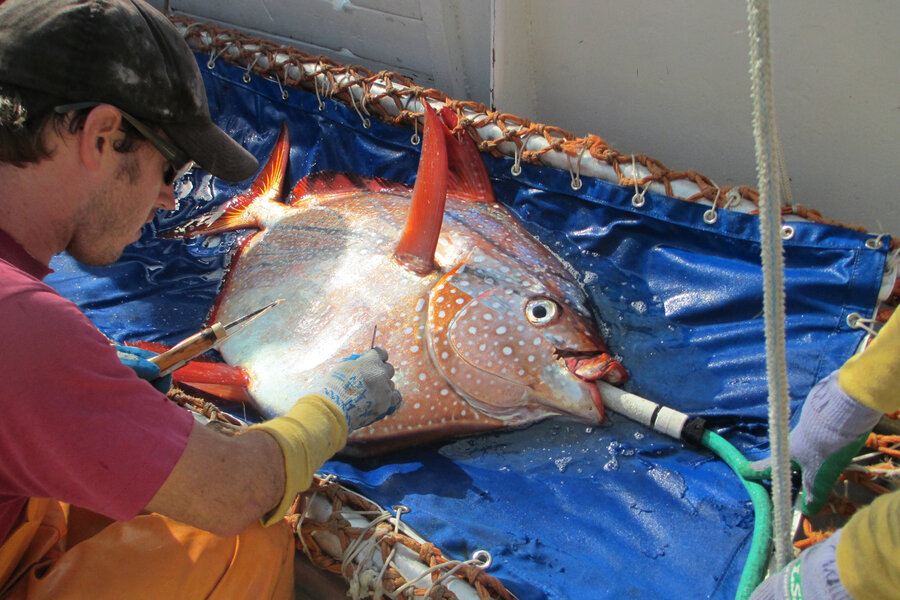Opah! First known warm-blooded fish flaps to generate heat
Loading...
What's the difference between a fish and a bird? As science reveals newer and stranger creatures, few hardline rules about classification remain. And one fish just knocked another rule off the table.
The opah is a large, deep-sea fish, commonly found off the coast of Hawaii and west Africa. It’s also the first and only fish known to be warm-blooded, or endothermic. A new study by NOAA Fisheries describes how the opah generates full-body heat by vigorously flapping its pectoral fins, and retains that warmth with a radiator-like system of arteries. Findings were published Thursday in Science.
Opah, or Lampris guttatus, can grow to be nearly 7 feet in length. The species belongs to the order Lampriformes, which is also home to various species of oarfish. Most lampriformes are slow-moving ambush predators, as they tend to live at frigid depths where intense physical activity is too energy-expensive. But powerful, horizontally positioned pectoral fins suggest that opah are capable of rapid movement.
While working toward his PhD, NOAA researcher Nick Wegner specialized in the respiratory adaptations of fast-swimming fish. Over time, he became a “gill expert” of sorts. So when co-author Owyn Snodgrass began pulling in opah on research trips, he reached out to Dr. Wegner with samples.
“The tissue he collected for me sat around in a jar for several months before I actually looked at it,” Wegner admits. “When I did, I saw many structural similarities to the gills of other fast swimming fish, which provided the first clue that this wasn't a typical sluggish, deep-dwelling fish. When I cut open one of the gill arches, I noticed an incredible network of blood vessels, something I had never seen before in the gills. Something no one had ever seen before.”
When opah flap their wing-like pectoral fins, the action heats their bodies internally. That thermal energy would normally be lost through the gills, where oxygen extracted from cold water would enter the bloodstream and cool the body. But in opah gills, these arteries run adjacent to another set of arteries carrying warm blood.
“This forms a counter-current heat exchanger,” Wegner says, “where warm blood from the body transfers its heat to the blood coming back into the body core from the respiratory surfaces of the gills. This series of heat exchanging blood vessels minimizes the loss of heat to the gills during respiration.”
This adaptation makes it possible for opah to keep their vital organs and cranial region several degrees warmer than the deep waters it lives in. Layers of fat are an extra defense, insulating critical areas from heat loss. Most fish are cold-blooded, keeping their bodies at the “ambient temperature” of the surrounding waters, although some tunas and lamnid sharks can warm parts of their bodies through a process called “regional endothermy.” The opah, however, is the only whole-body endotherm.
“Endothermy is particularly advantageous in cold or thermally-variable habitats,” Wegner says, “as it allows for increased physiological function at cold temperatures. For opah, having a warm body should give it advantages, like faster swimming and reaction times, over its cold-bodied prey and competitors. However, many species are highly successful at being cold, slow moving ambush predators. The cost of being warm is having higher energetic demands.”
Because endothermy has never been seen in a fish species before, Wegner and colleagues wondered whether it was an overlooked ancestral feature or a relatively new development.
“We looked at a related fish from the same habitat known as the king-of-the-salmon, Trachipterus altivelis,” Wegner says. “This fish lacks counter-current heat exchangers in its gills indicating that it cannot retain heat like the opah. In fact, the king-of-the-salmon has a very different body shape and appears to be a very sluggish ambush predator. This adaptation thus appears to be specific to opah.”
Besides being a perfect case study for how little we know about our oceans, Wegner’s finding blurs the distinction between classes. If endothermy isn’t unique to mammals and birds, it’s possible that the opah isn’t really alone in its adaptation. To that end, Wegner and colleagues are starting close to the source.
“The fact that we didn't know that the opah could warm its entire body until now goes to show how little we really know,” Wegner says. “There are currently two described opah species: the opah, Lampris guttatus, and the southern opah, Lampris immaculatus. We hope to be able to examine some southern opah in the future, as this species is known from the Southern Ocean where the water temperatures are even colder. That means endothermy would probably be even more advantageous, but also harder to maintain.”






